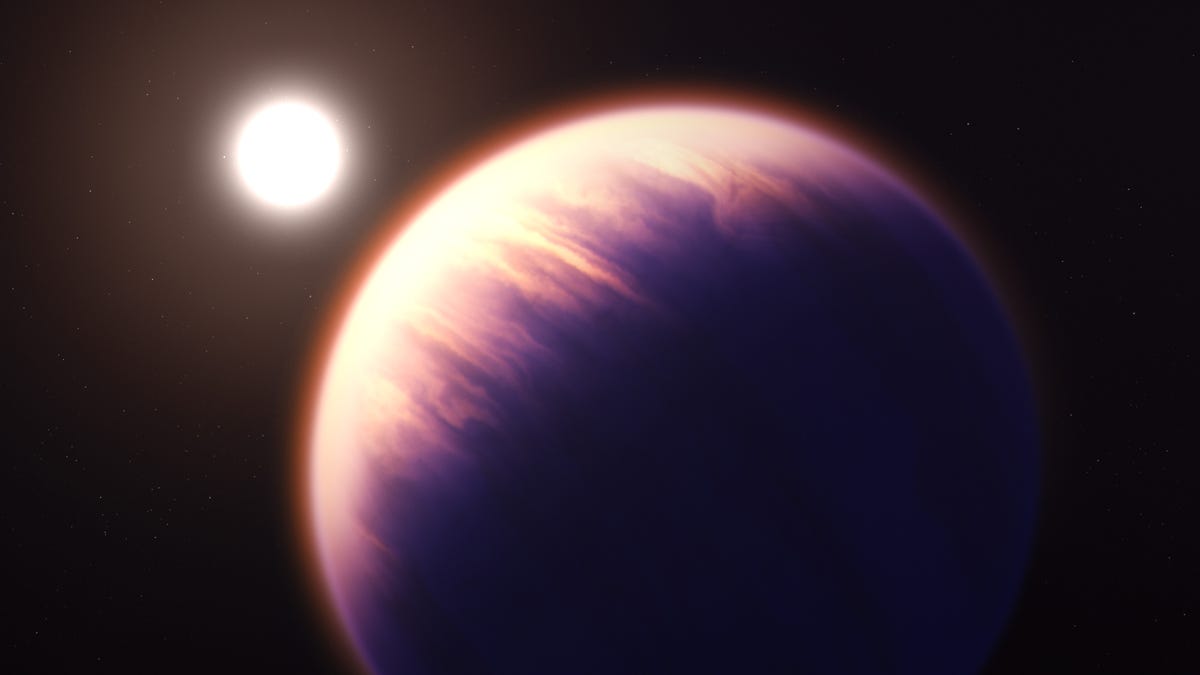NASA's Webb Telescope Paints Detailed Picture of a Nearby 'Hot Saturn' Exoplanet
WASP-39b isn't much of a destination, but it could light the way toward learning about more habitable worlds.

This illustration shows what exoplanet WASP-39 b could look like, based on current understanding of the planet.
Nearby exoplanet WASP-39b is broiling hot and certainly not a vacation destination for humans, but emerging details about its atmosphere coming courtesy of NASA's James Webb Space Telescope have astronomers amped over what could soon be revealed about other worlds.
"We observed the exoplanet with several instruments that together cover a broad swath of the infrared spectrum and a panoply of chemical fingerprints inaccessible until JWST," astronomer and research team member Natalie Batalha said in a statement. "Data like these are a game changer."
Earlier research based on Webb observations already revealed the first clear detection of carbon dioxide at an exoplanet on WASP-39b. Now a raft of five new academic studies out Tuesday provides a more comprehensive profile of what's cooking in the sky over this world 700 light-years from Earth, or just around the corner on the cosmic scale of the universe.
Here’s my list of 10 things to take away from this collection of papers: pic.twitter.com/bXdMGcjByp
— Natalie Batalha (@nbatalha@mastodon.social) (@nbatalha) November 22, 2022
In addition to CO2, Webb detected water, sulphur dioxide, carbon monoxide, sodium and potassium in the atmosphere. The sulphur dioxide is particularly interesting, because it is known to be created by photochemical reactions between light and water.
"This is the first time we have seen concrete evidence of photochemistry -- chemical reactions initiated by energetic stellar light -- on exoplanets," said Shang-Min Tsai, a researcher at the University of Oxford and lead author of one of the papers, which has been submitted to the journal Nature.
So how is SO2 formed? Our models shows that stellar UV drives the reactions to convert H2S (hydrogen sulfide) into SO2, confirming the pioneer work by @zahnleofdune. But what does it mean? It means we've got robust evidence of photochemistry on exoplanets for the 1st time! pic.twitter.com/KFHfxijGXu
— Shang-Min (Shami), Tsai (@ShamiTsai) November 22, 2022
The planet also appears to be less cloudy than Saturn, which is pretty much always covered in dense cloud decks. The weather on WASP-39b, by contrast, occasionally calls for just patchy clouds.
The large size of the planet, comparable to Saturn, and its proximity to its star -- it orbits closer than Mercury does to our own sun -- already suggest that nothing like life as we know it could survive on WASP-39b. But the new results show promise for Webb's abilities that could be applied to more Earth-like planets such as those in the Trappist-1 system.
"We are going to be able to see the big picture of exoplanet atmospheres," said team meber Laura Flagg, a researcher at Cornell University. "It is incredibly exciting to know that everything is going to be rewritten. That is one of the best parts of being a scientist."

